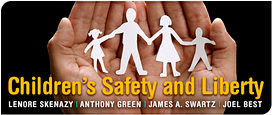The core philosophy of Safe Kids is that the overwhelming majority of the risks in which we engage are preventable.
- Deaths from car crashes can be reduced if people wear seat belts and properly place their young children in a correctly installed car seat. Other ways to minimize deaths from car crashes are through graduated drivers licensing schemes and interlock brakes.
- Kids are much less likely to be poisoned by getting into medication if a parent keeps them out of reach and out of sight.
- And if they do get into medications or dangerous substances, the harm is likely to be resolved much more quickly by calling a poison control center—1-800-222-1222—our health care system’s secret weapon.
- If a kid wears a bicycle helmet, he is less likely to suffer a serious concussion and other injuries.
- If parents, coaches, and kids follow the common sense protocol for when a young athlete might suffer a traumatic brain injury, kids playing on football fields, soccer fields, and basketball courts will be much safer. Parents anxious about this danger because of the ubiquitous news about sports concussions will be able to breathe some relief.
Further, sensible prevention measures save society tax dollars.
- Every dollar spent on a booster seat saves society $71.
- Every dollar invested in a smoke alarm saves $28.
- A helmet on the head of a younger bicyclist saves $580
- Each federal dollar spent to support poison control centers saves $38.74.
As much as the child safety deniers would like to think otherwise, those of us engaged in child safety do think about cost-benefit in the spirit of a holistic formula leading to what works. We think about what’s the surest cure we can prescribe in the most cost-effective way possible, because resources are limited and the caffeinated media world in which we live can sustain only so many messages. It’s unhelpful when Mr. Best resorts to “World’s Worst Mom” talk with his 5 mph speed limit hypothesis.
Here’s a real example. I have spoken in this debate about the horror involving a child dying of heat stroke, left alone in a car by a parent or caregiver. What’s the remedy? In addition to education, technological answers were considered. The National Highway Traffic Safety Administration (NHTSA) commissioned the Center for Injury Research and Prevention at Children’s Hospital of Philadelphia to conduct a study to determine if technology or engineering could provide an answer. It was determined that no current technological remedy would be effective or reliable. Until there’s a real technological remedy for this problem, education is our most effective intervention. Though NHTSA is a leader in the effort, the predominant awareness work is being conducted by safety professionals in the non-profit world.
Reminding parents about common sense responses to risk has great benefit and little cost. Another example just hit my screen: The Florida Orlando-Orange County Expressway Authority has launched an education campaign urging drivers to have a “designated texter,” building from MADD’s success on designated drivers. A Harvard study estimated that between 1988, when it was launched, and 1998, the designated driver campaign saved 50,000 lives.
Mr. Best seems to suggest that safety professionals are constantly shopping for problems as “larger ones” are resolved. I imagine Mr. Best would identify distracted driving as another “smaller” problem which consumer safety advocates have dreamed up.
Further, in many cases, education and awareness are hugely successful interventions. Education is not an imposition; not a law, regulation or mandate. We pick and choose what we listen to. As I have said before, awareness is part of the DNA of freedom.
If the work we’re doing gets to the point that we run out of genuine risks to resolve, I am happy to look for another job. There’s an audacity in getting to zero, and audacity is a wonderful challenge.

